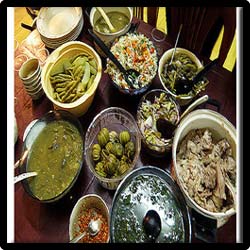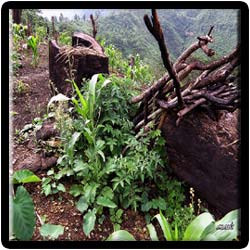CULTURE IS THE ART OF LIVING
The people of Mizoram are popularly known as Mizos. The historical origin of the people of Mizoram is from the Mongolian race and distributed in the north- eastern part of the country centuries ago. During the 7th century these people had a temporary stay in Western Burma and China. Then in the 9th century at the time of the entry of the British Missionaries, the Mizos entered into India and got influenced by the Britishers and got themselves following Christianity. Various activities of the British Missionaries resulted in educating the people, influencing the Mizo language with Roman Script. It soon became a formal way of education. Kukis were the first set of Mizo people who migrated to India and was followed by the second batch of immigrants who were called New Kukis. During the ninth century under the influence of the British Missionaries the last set of Mizo people namely the Lushais came into the country and settled in the hilly area of Mizoram.
The culture of Mizoram can be best expressed as comprising the following:ORIGIN AND ETHINICITY
The Mizo people are mostly Christians and scheduled tribes occupying Mizoram in majority. The Mizo history in the 18th and 19th Century is marked by several instances of tribal raids and retaliatory expeditions of security. There are no differences in class and no discrimination on grounds of sex. The Mizo people follow a special code of ethics namely Tlawmngaihna which always keep them in a close knitted society which keep them intact and characterized by features like honesty,helpful, soft-natured, sociable, considerate and loving each other.The Kukish language owned by the Mizo people with various ethnic groups of people living in the north eastern part of India originated from western Burma (Myanmar) and eastern Bangladesh. Initially the union territory of Mizoram called as Lushai hills was under the geography of the state of Assam. Later this Union territory progressed into a full-fledged state. The earliest inhabitants of Mizoram were the Lusei people to have an external exposure and hence the ethnicity was initially known as the Lushai people. Though they fall under various clans like Paite, Lushei, Ralte, Gangte, Mara, Pawi, Himar, Pangs and Kukis, etc, they still call themselves as Mizo which came as a result of their demand and struggle in unity as Mizos for a separate political territory. Lusei Duhlian is the most common dialect used by the Mizo people and it belongs to Tibeto-Burman. The Mizo does also have a close knot to the Chins living in the state of Burma and to the Kukis. The ethnicity of the Mizo people are based on various factors like their different tribal groups, religions, rituals and festivals but still they all live in peace and harmony adhering to their old socio-cultural lineage.
CULTURE
The cultural boundary of the people of Mizoram is mainly based on the tribal community who are popularly referred to as the Mizos.Though the Mizo people have lot of influences by the foreign intrusions they still strictly try to maintain their lifestyle and traditional culture without causing any harm to it. As a result of their rich cultural heritage the Mizo people celebrate lot of fairs and festivals. The fact that the Mizo people are so referred came from the term Mizo which can be bifurcated into 'Mi' meaning people and 'Zo' that signifies the hill meaning they hail from the highland. The Mizo people take pride in their cultural diversity for though now Mizoram too is moving towards modernization but the state government has ensured that every bucolic hamlet in the state, irrespective of its remote location, is endowed with an YMA (Young Mizo Association). The people belonging to the Young Mizo association take care in maintaining the traditional values and customs to be followed and kept alive by the upcoming generations. FAIRS AND FESTIVALS
The three major festivals celebrated by the Mizo people are Chapchar Kut, Pawl Kut, and Mim Kut which are associated with agricultural activities. The Chapchar Kut festival is celebrated in the month of March after clearing and burning of the remnants of the jungle. In the month of December they celebrate the straw harvest festival. The reaping of Maize is celebrated as Mim Kut festival in the month of August and September during which the people conduct a fair and illegally drinking beer made from rice, dancing, feasting, and singing. All these festivals are accompanied by traditional music and dance. FAIRS AND FESTIVALS
The three major festivals celebrated by the Mizo people are Chapchar Kut, Pawl Kut, and Mim Kut which are associated with agricultural activities. The Chapchar Kut festival is celebrated in the month of March after clearing and burning of the remnants of the jungle. In the month of December they celebrate the straw harvest festival. The reaping of Maize is celebrated as Mim Kut festival in the month of August and September during which the people conduct a fair and illegally drinking beer made from rice, dancing, feasting, and singing. All these festivals are accompanied by traditional music and dance. DANCE
The Mizo people are known for their traditional folk dance which varies from one community to another. Cheaw Dance or the bamboo dance is the most famous dance of the Mizo people where they use the bamboo as the prop and dance according to rhythm. Khuallam dance is performed in groups mainly to welcome guests and the people are dressed in colorful attires during the performance. The Chheih Lam is a unique type of dance which is done over rice beer where the people form a round shape. This is performed mainly to honour the guests. MUSIC
Music is an indispensable part of the culture of the people of Mizoram. There are a lot of traditional folk songs of the Mizo's and they are named after various factors like Tribes, Invocation and Incantation, individuals and modulation of the voice. All these folk songs are accompanied with musical instruments like String instruments which include Tingtang, Lemlawi and Tuiumdar. Some of the beating instruments are Talhkhuang, Khuang, Dar, Bengbung and Seki. They also use wind instruments like Hnahtum, Mautawtawrawl, Rawchhem, Tumphit, Phenglawng and Buhchangkuang. CUSTOMS AND TRADITIONS
Though the religion of Christianity has influenced a lot, the people of Mizo still follow some traditional customs and rituals. Apart from very few customs like animal sacrifice which used to be an essential part of the culture is now considered to be a curse. The custom of paying Bride price is very common among the Mizo people. When a Mizo boy approaches his fiancees parents for permission to get married, the first thing he has to do is to settle the bride price. If the price among other things, demanded by him, is acceptable to the parents, the boy and the girl are allowed to get married. Part of the bride price is paid during the wedding and the rest is paid over the years. A Mizo wedding first involves engagement during which the girl and the boy are permitted to mix freely and if they get along then the elders fix the wedding whereas if they don't get along they have rights to break. Majority of the population being Christians, the marriages are held in the Churches where there is a custom of the wife to bring a traditional rug called Puandum in which the body of the boy is to be wrapped during burial. In case of the bride having no brothers then the boy goes to the girl's family and takes care of things. This custom is called as Makpa chhungkhung. The other types of marriages include Luhkhung and Tlandun where the former involves wedding which is performed in case of a pregnant girl with the boy responsible for her condition and it generally takes place without much fun. COSTUMES
The Mizo people are known for their intricate designing which can be done only in their looms and they generally known as born weavers. The mottos and patterns used by the Mizo people in their designing has become a part of their cultural heritage and it is passed on to generations. Puan is one of their traditional garment which is used both by the men and women more or less in the same manner and each work involved in designing these garments has a story to tell. These traditional hand woven apparels are of different shades and designs without exquisite play of colour combination and intricate weaving patterns has been evolved. Some of their traditional attires includes Puanchei which is very colourful and is used by every Mizo lady. The ladies of the Mizo community use Kawrchei which is a unique distinctive blouse. Ngotekherh is a traditional cloth used by the men to tie around their waist, but however now it is also used by the women.Cyhna Hno is another embroidered silk puan of the Mara's used by both men and women. ARTS AND CRAFTS
The Mizo people are known for their handloom and handicraft products which mainly include textiles, bamboo and cane works and basketry. The Mizo ladies are known as born weavers and they produce a wide range of textile products like puanspuon dum, puon pie, thangou puon, puon laisen, jawl puon, thangsuo puon, hmarm and zakuolaisen. Apart from textiles they also excel in items made of bamboos and canes like toys, hats, animal and fish trapscones, baskets, jewelry boxes, utensils, household items and smoking pipes. The smoking pipes are of two types namely the Vaibel and Tuibur pipes where the former made of bamboo is used by the men and the latter made of clay and bamboo is used by the women. CUISINE

Other favorite dishes include Misa Mach Poora, Panch Phoron Taarkari, which is actually a grilled preparation of shrimps, Dal with Eggs, Poora Mach and Koat Pitha.The Mizo's avoid oily food. Mustard oil is the most common oil used in cooking.
OCCUPATION

Apart from agriculture the other major industries include handloom and handicrafts, agro and forest-based industries and electronics and consumer industries. Sericulture is also gaining importance among the people.


